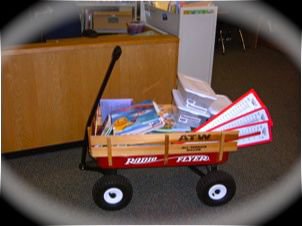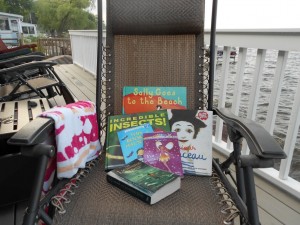The walls of the Orchard School Library Media Center faded away last week as young learners from South Burlington, Vermont met with friends in several elementary schools across the country via Skype and Google Hangout. As participants in the Global Read Aloud project, readers throughout the United States and beyond read and discuss books both synchronously and asynchronously for six weeks beginning in October. Educators who jump into the Global Read Aloud are encouraged to find creative ways to incorporate the joys of shared reading both locally and globally.
School Library Media Center faded away last week as young learners from South Burlington, Vermont met with friends in several elementary schools across the country via Skype and Google Hangout. As participants in the Global Read Aloud project, readers throughout the United States and beyond read and discuss books both synchronously and asynchronously for six weeks beginning in October. Educators who jump into the Global Read Aloud are encouraged to find creative ways to incorporate the joys of shared reading both locally and globally.
Through the GRA website and wiki, teachers and librarians can collaborate with each other and their classrooms through Twitter, Edmodo, Skype, Kidblog, and other social media sites. The project began in 2010 with a Wisconsin educator, Pernille Ripp, who envisioned a read aloud that would connect kids and books beyond the classroom. The program has grown exponentially, from 150 in 2010 to over 300,000 student participants from over 60 countries in 2014. The GRA 2015 has kicked off with four middle grade titles for discussion this year, and an author study for the picture book crowd.
- Listen to Pernille explain the purpose and goals for Global Read Aloud in this short video in the GPR wiki: http://globalreadaloud.wikispaces.com/
- Be sure to look at the extensive resources that are included on that site and also the home website for the GRA. http://theglobalreadaloud.com/
GRA in Action at Orchard
At Orchard School, the library media specialist, Donna Sullivan-Macdonald also wears the tech integrationist hat, and the school library program is an active hub of learning and literacy that connects the school to the world beyond. The Global Read Aloud Project is high on Donna’s list of real world connections. She has participated in the GRA since 2011 with one class of fifth graders, and this year the project includes all twenty classes, kindergarten through fifth grade. Each class is paired with a class in another state, and the students have had fun getting to know one another through Mystery Skypes, Google Hangouts, sharing Padlets, writing and responding to blog posts, tweeting, taking surveys, and exchanging emails. To get a flavor of how the connections work, Donna tells about using the 2015 GRA with some of her students:
“For the Amy Krause Rosenthal picture book author study, kindergarten and first graders heard the first book in the project, Chopsticks, and then learned to use the tool. We’re now creating a shared book of pictures of students eating with chopsticks with some new friends in the state of Georgia.”
When I visited last week, Donna read another book by Rosenthal, It’s Not Fair, to a class of second graders, and explored concepts about fairness and taking turns by arranging for two activities for the class. The object was to make sure that all had equal time for the activities. Fifteen minutes before the end of the class time, the students got together via Hangout with their buddy class in Indiana to discuss the book and ideas about fairness. It was amazing to see the Orchard students actually having an interactive discussion with kids miles and miles away.
Local Connections
Connecting reading to the world is not limited to just the Global Read Aloud at Orchard School. Another ongoing project is a Food Drive that has been inspired by Katherine Applegate’s newest book, Crenshaw. The author of The One and Only Ivan has provided much food for thought for her reading fans. The topic of homelessness is sensitively addressed, and readers can make connections with real world problems and can learn to make a difference. The publisher has launched a program #crenshawfooddrive that invites independent bookstores to raise awareness about childhood hunger based on ideas from Applegate’s book. Crenshaw is imaginary. Childhood hunger isn’t. Help us feed families in need. http://www.mackidsbooks.com/crenshaw/fooddrive.html
In August, Donna contacted Phoenix Books in Burlington and suggested that they could work as partners to contribute to the food drive for the Chittenden Emergency Food Shelf.
Donna explains how Crenshaw sparked a study of childhood hunger at Orchard School:
“The fifth grade teachers read Crenshaw as their first read aloud this school year. In the library, we researched childhood hunger and presented this information on posters, created in both in the makerspace and on the computer. Students also created a slide show on childhood hunger and ran a whole school morning meeting introducing the food drive to the school. There were speakers from both Phoenix Books and the Chittenden Food Shelf. No teachers spoke. It was student driven. Heading into the final week, we’re at 819 items donated!
Back to Crenshaw, many 2nd through 4th grade teachers have since read the book to their classes. I have used Amy Krouse Rosenthal’s message about random acts of kindness in my discussions with K-3 students who are reading her books.
On Friday, after reporting final totals to the school at morning meeting, one fifth grade class will load all of our donations on a bus and we’ll head to the food shelf for a tour and a weighing of all the donated food.
It’s heartwarming to witness the kindness and empathy shown by young children through participation in this project.
Although not formally a part of GRA, the food drive has fit in nicely.”
For Donna, and the many other talented teacher librarians and educators in our schools, celebrating literacy is an everyday joy that is embedded within the fabric of a culture of collaboration that makes a school a vibrant and caring place for our students and our colleagues.
Thank you Donna for sharing your enthusiasm and energy, and thank you to your students who are making a difference locally and globally!
Resources:
Applegate, Katherine. Crenshaw. New York: Harpercollins, 2015.
Kaplan, Judith. “Donna Sullivan-Macdonald.“ Personal Interview and email correspondence. 20 Oct. 2015.
Twitter: http://twitter.com/dsmacdonald
LinkedIn: http://www.linkedin.com/pub/donna-macdonald/35/723/416
Orchard School Library Media Center, 2 Baldwin Ave. So. Burlington, VT 05403 Web. Oct. 25, 2015.<http://library.sbsd.orchard.schoolfusion.us/modules/groups/integrated_home.phtml?gid=771938>.
Ripp, Pernille. “Home.” GlobalReadAloud. Wikispaces, 2015. Web. 26 Oct. 2015. <http://globalreadaloud.wikispaces.com/>.
Images: Judy Kaplan Collection







